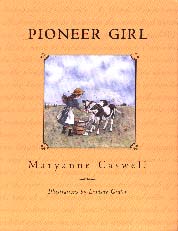| ________________ CM . . .
. Volume VIII Number 5 . . . . November 2, 2001
excerpt:
The historical value of artifacts like letters or journals is undeniable. Authenticity, however, comes with its own problems. Pioneer Girl is a collection of such letters, written in 1887 by 14-year-old Maryanne Caswell to her grandmother. Maryanne and her family had left a comfortable home in Palmerston, Ontario, to eke out a life in Canada's new West. The letters, published first in a newspaper in 1952, then as a book in 1964, are a recounting of the trials her family faced as they traveled to a paradise that ultimately fell short of her dreams. From Maryanne's deeply detailed reports of her new experiences, readers get a fascinating glimpse into the reality of pioneer life. The land is depicted as by turns bleak and uplifting. The family's many trials are laid bare, as are their solutions. Particulars are plentiful in Maryanne's descriptions of chores: building a house; making soap, cheese and barley coffee; planting crops and haying; snaring pesky gophers; gathering hailstones for water; and rounding up the ever-wandering cows and sheep. With the help of Lindsay Grater's black-and-white drawings, readers can easily start building an image of this life long past. The dozen illustrations in this re-issue are a fitting match, too; readers can easily imagine them to be sketches made by the author herself. Doll-like in quality and size, the drawings also aptly convey the immensity and isolation of the prairies. The image isn't, however, a complete one. Maryanne's letters, intended as private correspondence, make no concessions to an audience of uninformed strangers. We're often left wondering: what is "oop" sugar, anyway, and what innocent remark cost Maryanne her inheritance? Who are all those people she mentions by name, and which should we make important? Also, since only the first and last letters are dated, readers in today's high-speed world will find it hard to tell how long each part of the journey lasted. The preface explaining the historical circumstances that led to the family's decision to move is absolutely necessary - little else places the story in Canada's timeline. There's disappointingly little in the letters about the railway, so vital to the country, or Confederation, still relatively new. A map showing Confederation-era Canada could have been added as well, to show a country in transition and to allow readers to trace the family's journey. Readers might also question the portrait of Maryanne that emerges from her letters. She's amazingly reliable, optimistic and courageous, displaying little of fear, loneliness and homesickness. She's perfect, in fact, for the hardships that await her. She often appears cold, even mercenary. The only sorrow she expresses at the news of her grandfather's passing is over being left less money than expected. Similarly, when her uncle dies, she talks only about what they will do when they receive their share of his estate. How close she is to them is undisclosed, but even brother Andrew's death appears a casual event, included amid news of potato planting and the establishment of their temporary shanty home. This matter-of-factness is too much at odds with her appreciation of beauty not to provoke questions. She is enraptured, for example, by her first prairie crocus and notes with a poet's soul the sound of a "frog's orchestra," birds "that sang heel-toe and a one-two-three," and a wind that had fallen, "sighing softly as if in relief of duty done." How much of the pragmatism is a front to ease the mind of her grandmother? Written to a friend, would the letters read differently? A story with such limitations would likely be reworked. But as a collection of authentic letters, Pioneer Girl stands as is, and readers must simply rise to the challenge. No worries, however. It's a challenge worth taking. Recommended. Cora Lee is a Vancouver writer and editor.
To comment on this
title or this review, send mail to cm@umanitoba.ca.
Copyright © the Manitoba Library Association. Reproduction for personal
use is permitted only if this copyright notice is maintained. Any other
reproduction is prohibited without permission.
Published by NEXT REVIEW | TABLE OF CONTENTS FOR THIS ISSUE - November 2,
2001.
AUTHORS | TITLES | MEDIA REVIEWS | PROFILES | BACK ISSUES | SEARCH | CMARCHIVE
| HOME
|
